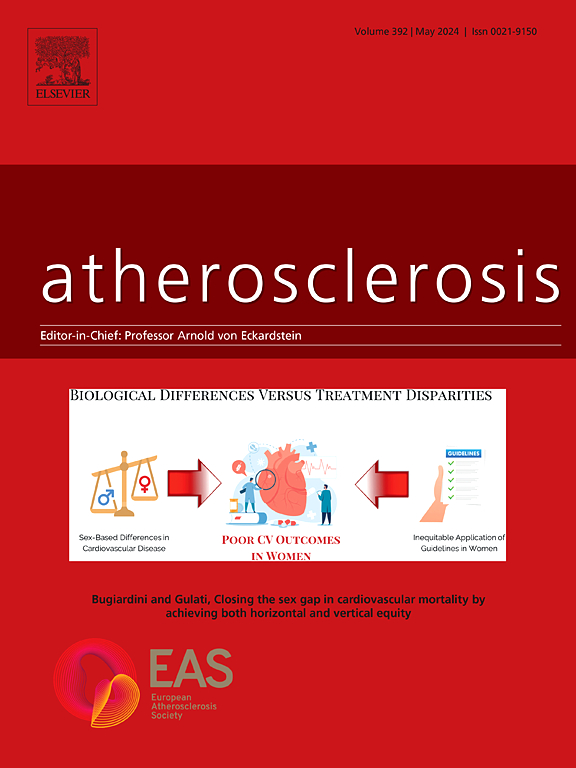Association of lipoprotein(a) and diabetes in primary prevention of coronary heart disease: The Multi-Ethnic Study of Atherosclerosis (MESA)
IF 5.7
2区 医学
Q1 CARDIAC & CARDIOVASCULAR SYSTEMS
引用次数: 0
Abstract
Background and Aims
Lipoprotein(a) [Lp(a)] and diabetes are both independently associated with cardiovascular disease. Studies demonstrate that elevated Lp(a) is associated with increased incidence of cardiovascular disease in those with and without diabetes. However, it is unclear if Lp(a) modifies the association of diabetes and coronary heart disease (CHD) in primary prevention.
Methods
The present analysis included 6668 participants from the Multi-Ethnic Study of Atherosclerosis, a community-based cohort without clinical cardiovascular disease at baseline. Participants were categorized as follows: group 1: Lp(a) < 50 mg/dL without diabetes, group 2: Lp(a) ≥50 mg/dL without diabetes, group 3: Lp(a) < 50 mg/dL with diabetes, and group 4: Lp(a) ≥50 mg/dL with diabetes. Survival analysis using Kaplan-Meier and multivariable Cox proportional hazard models were performed to assess the relationship between Lp(a), diabetes, and time to incident CHD.
Results
In a fully adjusted model, log[Lp(a)] and diabetes were both independently associated with CHD (HR: 1.10; 95 % CI: 1.01, 1.20) and (HR:1.65; 95 % CI: 1.31, 2.06), respectively. There was a significant multiplicative interaction between logLp(a) and diabetes (p = 0.033). Compared to the reference group (Lp(a) < 50 mg/dL without diabetes), in a fully adjusted model, those with Lp(a) ≥50 mg/dL without diabetes (group 2) had increased risk of CHD (HR: 1.29; 95 % CI: 1.00, 1.65). Similarly, individuals with Lp(a) < 50 mg/dL with diabetes (group 3) also had greater risk of CHD (HR: 1.52; 95 % CI: 1.16, 1.98). The highest risk for CHD were in those with Lp(a) ≥50 mg/dL with diabetes (group 4) (HR: 2.57; 95 % CI: 1.77, 3.72).
Conclusion
The results of this analysis suggest that Lp(a) may modify the association between diabetes and CHD or that diabetes may modify the association between Lp(a) and CHD in those without cardiovascular disease at baseline. Further research is needed to clarify underlying mechanisms between Lp(a), diabetes, and CHD.

脂蛋白(a)与糖尿病在冠心病一级预防中的关系:动脉粥样硬化的多民族研究(MESA)
背景和AimsLipoprotein(a) [Lp(a)]和糖尿病都与心血管疾病独立相关。研究表明,无论是糖尿病患者还是非糖尿病患者,Lp(a)升高都与心血管疾病的发病率增加有关。然而,目前尚不清楚Lp(a)是否在一级预防中改变糖尿病和冠心病(CHD)的相关性。方法本分析包括来自多种族动脉粥样硬化研究的6668名参与者,这是一个基线时无临床心血管疾病的社区队列。参与者分类如下:第一组:Lp(a) <;50 mg/dL,无糖尿病,2组:Lp(a)≥50 mg/dL,无糖尿病,3组:Lp(a) <;第4组:Lp(a)≥50 mg/dL,伴有糖尿病。采用Kaplan-Meier和多变量Cox比例风险模型进行生存分析,评估Lp(a)、糖尿病和冠心病发生时间之间的关系。结果在全校正模型中,log[Lp(a)]和糖尿病均与冠心病独立相关(HR: 1.10;95% CI: 1.01, 1.20)和(HR:1.65;95% CI: 1.31, 2.06)。logLp(a)与糖尿病之间存在显著的乘法交互作用(p = 0.033)。与对照组比较(Lp(a) <;50 mg/dL无糖尿病),在完全调整模型中,Lp(a)≥50 mg/dL无糖尿病的患者(2组)冠心病风险增加(HR: 1.29;95% ci: 1.00, 1.65)。同样,Lp(a) <;50 mg/dL的糖尿病患者(3组)也有更高的冠心病风险(HR: 1.52;95% ci: 1.16, 1.98)。糖尿病患者Lp(a)≥50 mg/dL发生冠心病的风险最高(4组)(HR: 2.57;95% ci: 1.77, 3.72)。结论本分析结果提示Lp(a)可能改变糖尿病与冠心病的相关性,或者糖尿病可能改变基线无心血管疾病患者Lp(a)与冠心病的相关性。需要进一步的研究来阐明Lp(a)、糖尿病和冠心病之间的潜在机制。
本文章由计算机程序翻译,如有差异,请以英文原文为准。
求助全文
约1分钟内获得全文
求助全文
来源期刊

Atherosclerosis
医学-外周血管病
CiteScore
9.80
自引率
3.80%
发文量
1269
审稿时长
36 days
期刊介绍:
Atherosclerosis has an open access mirror journal Atherosclerosis: X, sharing the same aims and scope, editorial team, submission system and rigorous peer review.
Atherosclerosis brings together, from all sources, papers concerned with investigation on atherosclerosis, its risk factors and clinical manifestations. Atherosclerosis covers basic and translational, clinical and population research approaches to arterial and vascular biology and disease, as well as their risk factors including: disturbances of lipid and lipoprotein metabolism, diabetes and hypertension, thrombosis, and inflammation. The Editors are interested in original or review papers dealing with the pathogenesis, environmental, genetic and epigenetic basis, diagnosis or treatment of atherosclerosis and related diseases as well as their risk factors.
 求助内容:
求助内容: 应助结果提醒方式:
应助结果提醒方式:


